1995 PONTIAC BONNEVILLE wheel
[x] Cancel search: wheelPage 13 of 338
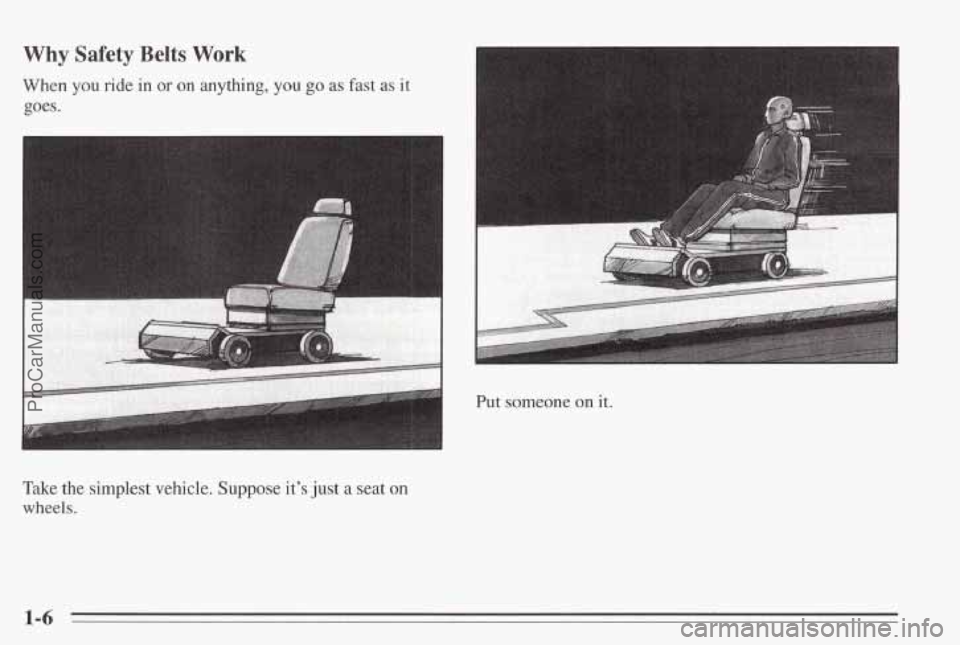
Why Safety Belts Work
When you ride in or on anything, you go as fast as it
goes.
c I
Take the simplest vehicle. Suppose it’s just a seat on
wheels.
Put someone on it.
1-6
ProCarManuals.com
Page 25 of 338
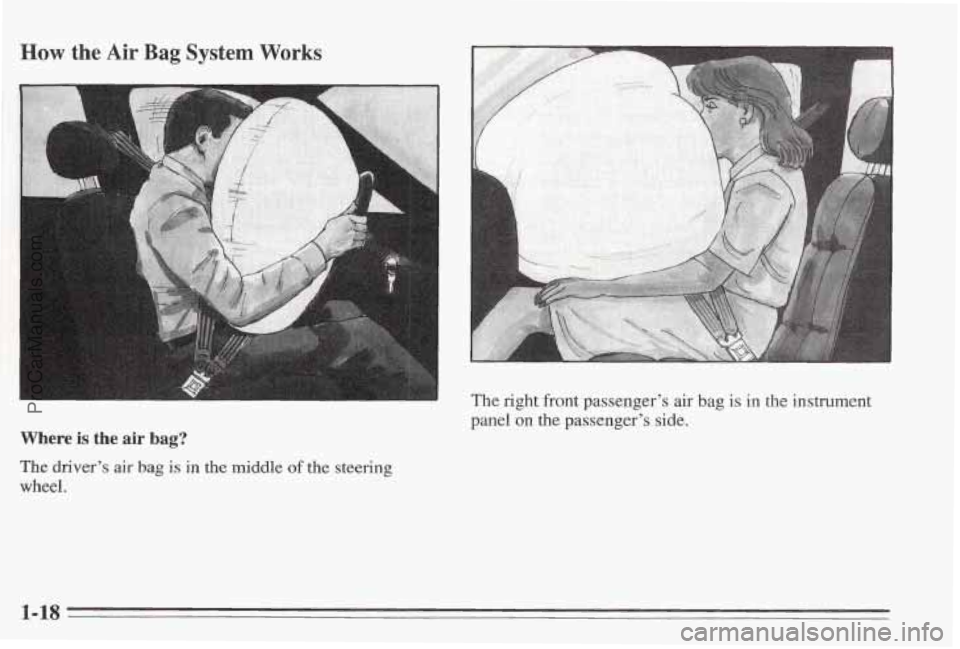
How the Air Bag System Works
,
The right front passenger's air bag is in the instrument
panel on the passenger's side.
Where is the air bag?
The driver's air bag is in the middle of the steering
wheel.
1-18
ProCarManuals.com
Page 26 of 338
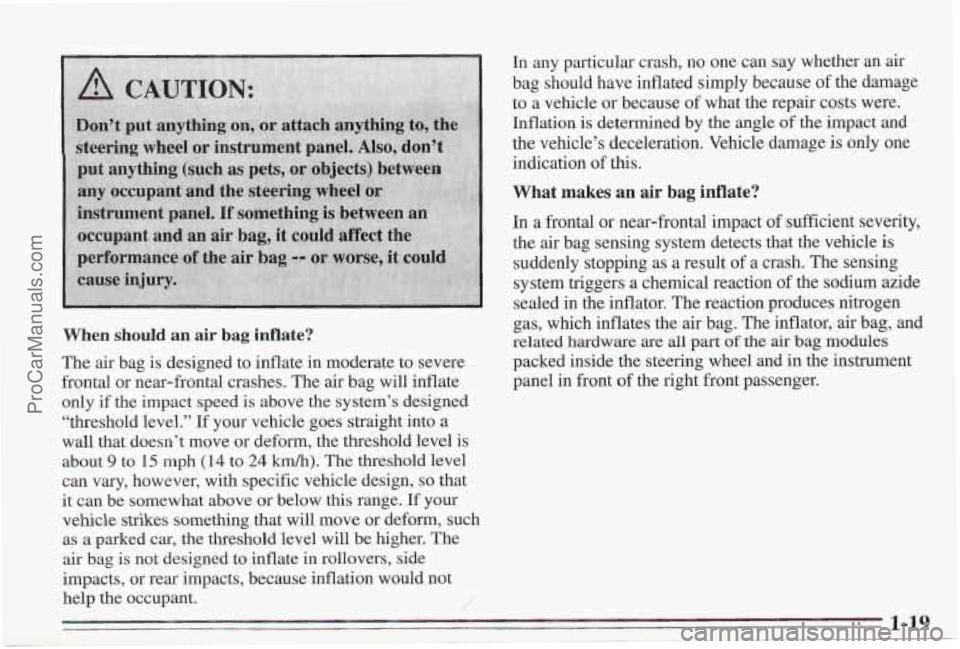
When should an air bag Mate?
The air bag is designed to inflate in moderate to. severe
frontal or near-frontal crashes. The air bag will inflate
only if the impact speed is above the system’s designed
“threshold level.”
If your vehicle goes straight into a
wall that doesn’t move or deform, the threshold level is
about 9 to 15 mph (14 to 24 km/h). The ~.esh~Ld level
can vary, however, with specific vehicle design,
so that
it can be somewhat above m below this range. If your
vehicle strikes’something that willmove ar defm, such
as
a parked car, th6 thre@mld level will be higher, The
air bag is not designed to’inflate
in rollovers, side
impacts, or rear impacts, because Mation
would not
help the occupant. /
In any particular crash, no one can say whether an air
bag should have inflated simply because of the damage
to a vehicle
or because of what the repair costs were.
Inflation is determined by the angle
of the impact and
the vehicle’s deceleration. Vehicle darnage
is only one
indication
of this.
What makes an air bag inflate?
In a frontal or near-frontal impact of sufficient seventy,
the
air bag sensing system detects that the vehicle is
suddenly stopping as a result of a crash. The sensing
system triggers a chemical reaction
of the sodium azide
sealed in the inflator. The reaction produces nitrogen
gas, which inflates the
air bag. The inflator, air bag, and
related hardware are
all part of the air bag modules
packed inside the steering wheel
and in the instrument
panel in front
of the right front passenger.
ProCarManuals.com
Page 27 of 338
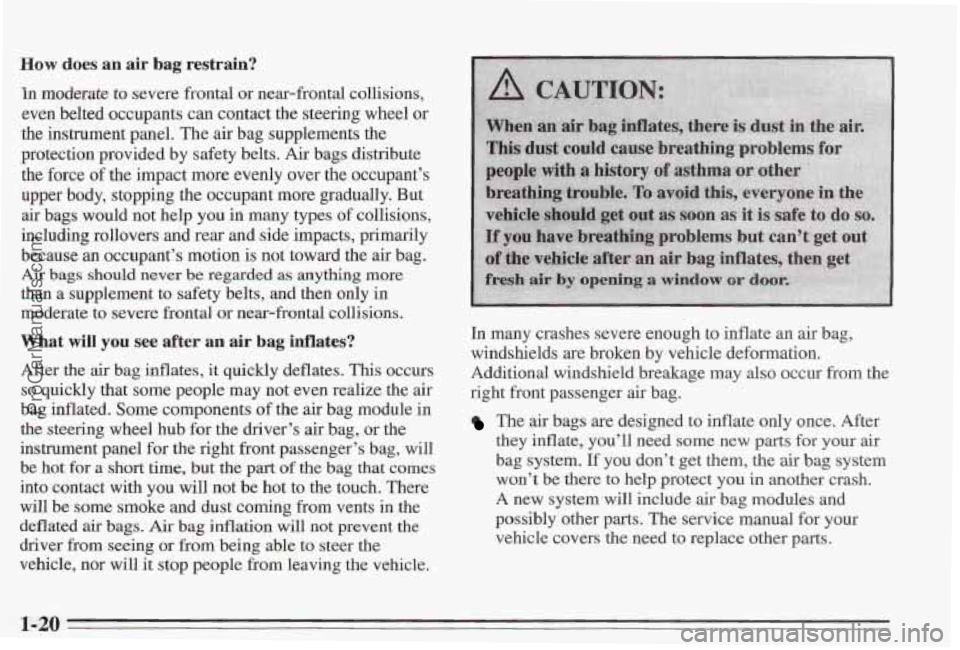
How does an air bag restrain?
In modmate to severe frontal or near-frontal collisions,
even belted occupants can contact the steering wheel or
the instrument panel. The air bag supplements the
protection provided
by safety belts. Air bags distribute
the force of the impact more evenly over the occupant’s
upper
body, stopping the occupant more gradually. But
air bags would not help you in many types of collisions,
including rollovers and rear and side impacts, primarily
because an occupant’s motion is not toward. the
air bag.
Air bags should never be regarded as anything more
than
a supplement to safety belts, and then only in
moderate to severe frontal or near-frontal collisions.
What will you see after an air bag inflates?
After the air bag inflates, it quickly deflates. This occurs
so quickly that some people may not even realize the air
bag inflated. Some components of the air bag module in
the steering wheel hub for the driver’s air bag, or the
instrument panel for the right front passenger’s bag,
will
be hot for a short time, but the part of the bag that comes
into contact with you will not be hot to
the touch. There
will be some smoke and dust coming from vents in the
deflated air bags. Air bag inflation will not prevent the
driver from seeing or from being able to steer the
vehicle, nor will it stop people from leaving the vehicle.
When an air bag inflates, th
This dust could cause breathing problems for
people with
a history of asthma or other
breathing trouble. To avoid this, everyon
vehicle should get out as soon as it is safe to do
If you have breathing problems but can’t get
of the vehicle after an air bag inflates,
fresh air by opening a
In many crashes severe enough to inflate an air bag,
windshields
are broken by vehicle deformation.
Additional windshield breakage may also occur frm the
right Eront passenger
air bag.
The air bags are designed to inflate only once. After
they
inflate; you’ll need some new parts for your air
hag. system. If you Bon’t get them, the air bag system
won’t be there to help protect you
in another crash.
A new sys- wiIl include air bag modules and
possibly other parts. The service md for your
vehicle cov’ers the need to replace other parts.
1-20
ProCarManuals.com
Page 57 of 338
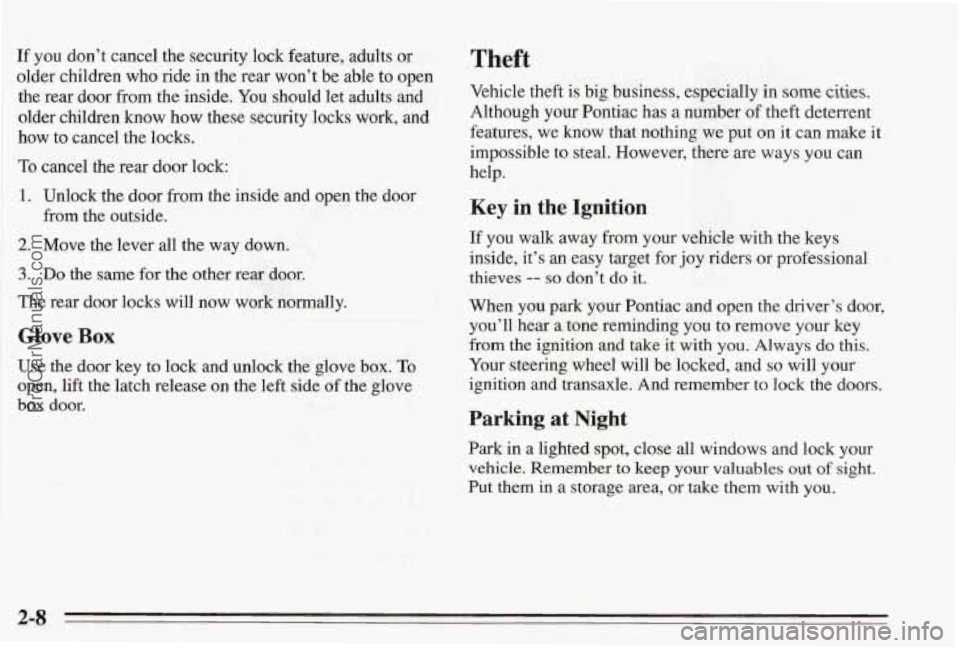
If you don’t cancel the security lock feature, adults or
older children who ride in the rear won’t be able to open
the rear door from the inside. You should let adults and
older children know
how these security locks work, and
how to cancel the locks.
To cancel the rear door lock:
1. Unlock the door from the inside and open the door
from the outside.
2. Move the lever all the way down.
3. Do the same for the other rear door.
The rear door locks will
now work normally.
Glove Box
Use the door key to lock and unlock the glove box. To
open, lift the latch release on the left side of the glove
box door.
Theft
Vehicle theft is big business, especially in some cities.
Although your Pontiac has a number of theft deterrent
features, we know that nothing we put on
it can make it
impossible to steal. However, there are ways
you can
help.
Key in the Ignition
If you walk away from your vehicle with the keys
inside, it’s an easy target for joy riders or professional
thieves
-- so don’t do it.
When you park your Pontiac and open the driver’s door,
you’ll hear
a tone reminding you to remove your key
from the ignition and
take it with you. Always do this.
Your steering wheel will be locked, and
so will your
ignition and transaxle. And remember
to lock the doors.
Parking at Night
Park in a lighted spot, close all windows and lock your
vehicle. Remember to keep your valuables out of sight.
Put them in a storage area, or take them with you.
2-8
ProCarManuals.com
Page 63 of 338
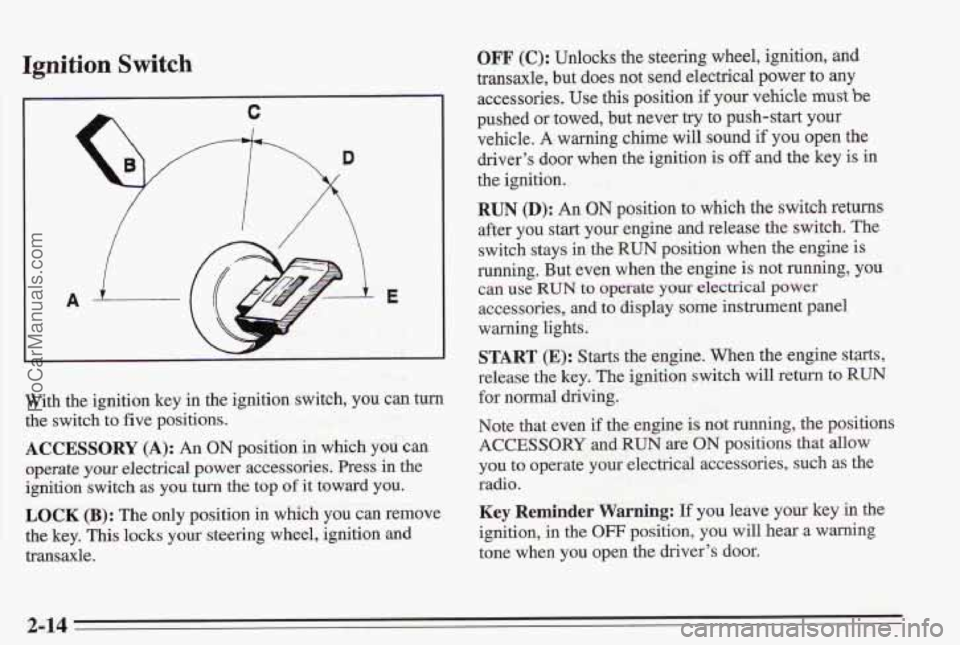
Ignition Switch
With the ignition key in the ignition switch, you can turn
the switch to five positions.
ACCESSORY (A): An ON position in which you can
operate your electrical power accessories. Press in the
igniti’on switch as you turn the top of it toward you.
LOCK (B): The only position in which you can remove
the key, This locks your steering wheel, ignition and
transaxle.
OFF (e): Unlocks the steering wheel, ignition, and
transaxle, but does not send electrical power to any
accessories.
Use this position if your vehicle me be
pushed or towed, but never try to push-start your
vehicle.
A warning cbime will sound if you open the
driver’s door when the ignition
is off and the key is in
the ignition.
RUN 0): An ON position to which the switch returns
after you start your engine and release the switch. The
switch stays in the RUN position when the engine is
running. But even when the engine is not running, you
accessories,
and to display some instrument panel
warning lights.
§TART (E): Starts the engine. When the engine starts,
release de key. The ignition switch will return to
RUN
for normal driving.
Note that even if
the engine is not running, the positions
ACCESSORY and RUN are ON positions that allow
you to operate
yom electrical accessories, such as the
radio.
Key Reminder Warning: If you leave your key in the
ignition, in the OFF position, you will hear a warning
tone when you open the driver’s door.
CEUl Use Rm to QPe3Tit.e yOlar &C!T’kd power
2-14 ProCarManuals.com
Page 64 of 338
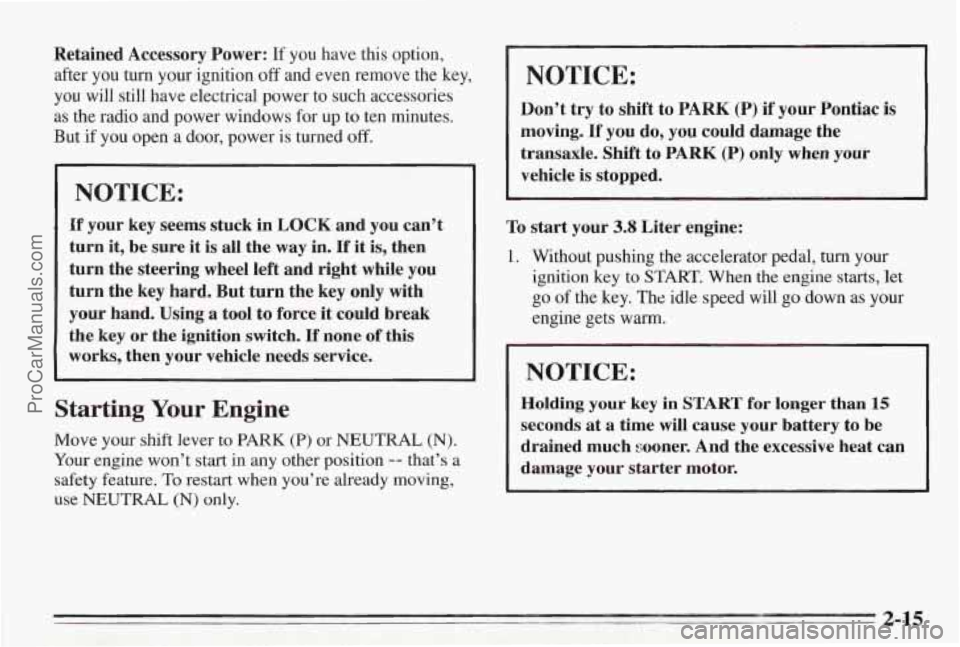
Retained Accessory Power: If you have ths option,
after you turn your ignition
off and even remove the key,
you will still have electrical power to such accessories
as the radio and power windows for up to ten minutes.
But if you open
a door, power is turned off.
NOTICE:
If your key seems stuck in LOCK and you can’t
turn it, be sure it is all the way in.
If it is, then
turn the steering wheel left and right while you
turn the key hard. But turn the key only with
your hand. Using a tool to force it could break
the key
or the ignition switch. If none of this
works, then your vehicle needs service.
Starting Your Engine
Move your shift lever to PARK (P) or NEUTRAL (N).
Your engine won’t start in any other position -- that’s a
safety feature.
To restart when you’re already moving,
use
NEUTRAL (N) only.
NOTICE:
Don’t try to shift to PARK (P) if your Pontiac is
moving. If you do, you could damage the
transaxle. Shift to PARK
(P) only when your
vehicle is stopped.
To start your 3.8 Liter engine:
1. Without pushing the accelerator pedal, turn your
ignition key to
START. When the engine starts, let
go of the key. The idle speed will go down as your
engine gets
warm.
NOTICE:
Holding your key in START for longer than 15
seconds at a time will cause your battery to be
drained much sooner.
And the excessive heat can
damage your starter motor.
2-15
ProCarManuals.com
Page 68 of 338
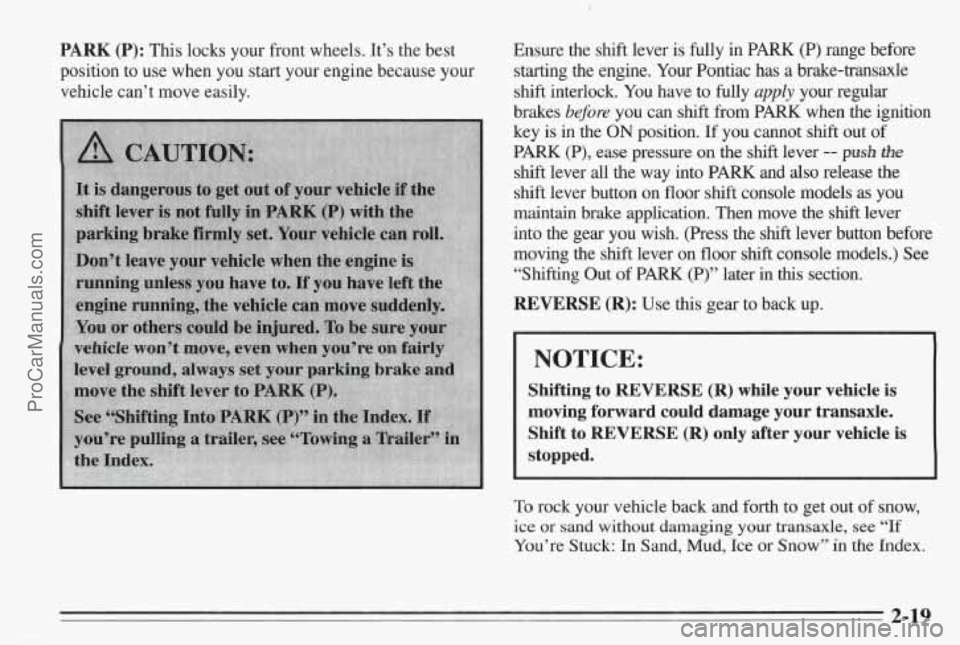
PARK (P): This locks your front wheels. It’s the best
position to use when
you start your engine because your
vehicle can’t move easily. Ensure the shift lever is fully in
PARK (P) range before
starting the engine. Your Pontiac has a brake-transaxle
shift interlock.
You have to fully apply your regular
brakes before you can shift from PARK when the ignition
key is in the
ON position. If you cannot shift out of
PARK (P), ease pressure
on the shift lever -- push t2ze
shift lever all the way into PARK and also release the
shift lever button on floor
shift console models as you
maintain brake application. Then move the shift lever
into the gear you wish. (Press the shift lever button before \
moving the shift lever on floor shift console models.) See
“Shifting Out of PARK (P)” later
in this section.
REVERSE (R): Use this gear to back up.
NOTICE:
Shifting to REVERSE (R) while your vehicle is
moving forward could damage your transaxle.
Shift to REVERSE
(R) only after your vehicle is
stopped.
To rock your vehicle back and forth to get out of snow,
ice or sand without damaging your transaxle, see “If
You’re Stuck: In Sand, Mud, Ice or Snow” in the Index.
2-19
ProCarManuals.com